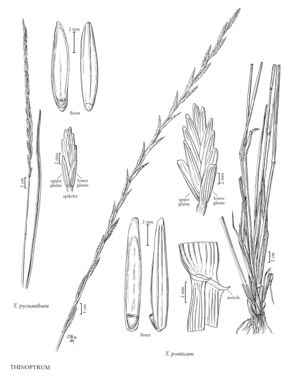Difference between revisions of "Thinopyrum pycnanthum"
FNA>Volume Importer |
FNA>Volume Importer |
||
| Line 29: | Line 29: | ||
-->{{Treatment/Body | -->{{Treatment/Body | ||
|distribution=Maine;Mass.;Wash.;Tex.;N.H.;Oreg.;Alta.;N.S.;R.I.;N.Y.;Pa. | |distribution=Maine;Mass.;Wash.;Tex.;N.H.;Oreg.;Alta.;N.S.;R.I.;N.Y.;Pa. | ||
| − | |discussion=<p | + | |discussion=<p>Thinopyrum pycnanthum is native to the coasts of western and southern Europe. It is reported from scattered locations in the western United States, and from Nova Scotia to Pennsylvania in eastern North America. In its native range, it grows in maritime sands and gravels, or river gravels.</p> |
|tables= | |tables= | ||
|references= | |references= | ||
| Line 45: | Line 45: | ||
|basionyms= | |basionyms= | ||
|family=Poaceae | |family=Poaceae | ||
| + | |illustrator=Cindy Roché and Annaliese Miller | ||
|distribution=Maine;Mass.;Wash.;Tex.;N.H.;Oreg.;Alta.;N.S.;R.I.;N.Y.;Pa. | |distribution=Maine;Mass.;Wash.;Tex.;N.H.;Oreg.;Alta.;N.S.;R.I.;N.Y.;Pa. | ||
|reference=None | |reference=None | ||
| Line 50: | Line 51: | ||
|publication year= | |publication year= | ||
|special status= | |special status= | ||
| − | |source xml=https:// | + | |source xml=https://bibilujan@bitbucket.org/aafc-mbb/fna-data-curation.git/src/314eb390f968962f596ae85f506b4b3db8683b1b/coarse_grained_fna_xml/V24/V24_546.xml |
|subfamily=Poaceae subfam. Pooideae | |subfamily=Poaceae subfam. Pooideae | ||
|tribe=Poaceae tribe Triticeae | |tribe=Poaceae tribe Triticeae | ||
Revision as of 16:08, 30 October 2019
Plants rhizomatous. Culms 10-120 cm, glabrous; lowest internode plus sheath 2-3 mm thick. Lower sheaths ciliate; auricles absent or to 0.5 mm; ligules 0.3-0.6 mm, truncate, ciliate; blades to 35 cm long, 2-6 mm wide, flat or convolute, glaucous, adaxial surfaces with 3-20 ribs, ribs prominent, crowded, flattened, scabrous. Spikes 4-20 cm; rachises glabrous; internodes 5-9 mm. Spikelets 10-20 mm, with 3-10 florets; disarticulation beneath the florets. Glumes 4.5-8 mm, glabrous, oblong-lanceolate, 4-7-veined, weakly keeled, keels asymmetric, scabridulous, midveins slightly longer and more prominent than the lateral veins, apices acute; lemmas 7-11 mm, glabrous, subobtuse, unawned, mucronate, or awned, awns to 10 mm; paleas keeled, keels ciliate; anthers 5-7 mm. 2n = 42.
Distribution
Maine, Mass., Wash., Tex., N.H., Oreg., Alta., N.S., R.I., N.Y., Pa.
Discussion
Thinopyrum pycnanthum is native to the coasts of western and southern Europe. It is reported from scattered locations in the western United States, and from Nova Scotia to Pennsylvania in eastern North America. In its native range, it grows in maritime sands and gravels, or river gravels.
Selected References
None.
